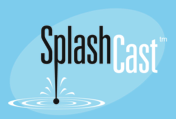Interview: SplashCast's Marshall Kirkpatrick

Update: Welcome Digg readers. Feel free to subscribe here (RSS).

SplashCast is a service that lets users create their own streaming media 'channels' that can combine various media including video, audio, photos, and text. The result is then packaged into SplashCast's flash-based media player so that it can be embedded on any web site, blog, or social network page. When channel owners modify their channel, the content is automatically updated wherever the player has been embedded.
Obvious uses for SplashCast include creating an automatically updated channel of content you've produced and own (such as this one), or as a way of creating a play list for other people's content that you wish to 'mash up'. There's a lot of power hidden under SplashCast's bonnet, such as the ability to grab existing content from YouTube and Flickr (individually or via an RSS feed), import Powerpoint presentations (more death by Powerpoint!), or record video directly from a webcam.
I caught up with SplashCast's Marshall Kirkpatrick (via email) to find out more.
You're official title is 'Director of Content' and according to the website your remit includes "evangelizing SplashCast to the blogosphere" (which sounds fun). Tell us a little bit more about your role at SplashCast.
I spend as much time as I can watching the content that our users publish in our catalog so I can help people make the most of the service and find the best stuff to highlight on our front page.
I also work with bloggers to integrate SplashCast into their blogs and probably most importantly, I blog myself using SplashCast to supplement my text coverage of industry news with mixed media content the way only SplashCast can. So I work to break news and cover tech just like I when I wrote at TechCrunch, but concerning the specific topic of online media and using media myself to demonstrate what our service can do. My co-worker Alex Williams, founder of the Podcast Hotel, is also a hard core social media guy, so we team up. It's a strategy that's worked very well for SplashCast so far. It's an awesome job. I feel really lucky to be able to do it.
I think, in fact, that it's an increasingly common model - hiring an in-house content creator to participate in social media to raise the public profile of your company. It brings up questions of editorial objectivity in what I produce, but I approach that thoughtfully and I believe I produce content that's appropriate given my role in the company. It's a lot of fun.
Who is the service aimed at?
I think of SplashCast as a media platform, really, that can be used by many different types of people and organizations. We let you work with video, audio, photos, PowerPoint and PDF files and RSS feeds -- so you can imagine the breadth of users who can plug into one or more of those media types.
We're really aiming the service at anyone who's looking for an easy to use but professional looking and powerful way to display and/or distribute multiple files of mixed media. So far we've got tech bloggers, video bloggers, educators, sports commentators, conference organizers, photographers, MySpace users, organic food advocates and probably a disproportionate number of religious organizations using SplashCast. Lots of Europeans, which is cool.
Give us some examples of how users have been utilizing SplashCast.
There's a number of self-made online video networks built with SplashCast at their core - like Growing Goodness (local food), Stuff We Like (gaming), ZenCast.tv (Zen), EnglishFeed (English as a Second Language) and ParableCast (Evangelical Christianity).
There's also a whole lot of people using SplashCast to publish small groups of videos or photo slide shows to their blogs. We'd like to see more podcasters using SplashCast, but there are some now.
We've also got high profile folks using SplashCast like Intel's Suite Two, General Motors' I Got Shotgun and the TED Conference.
The video publishing and syndication space seems to be pretty crowded. What is unique about SplashCast?
That's both true and not. Mixed media syndication is actually not crowded at all, we're the only company that allows you to put together live channels of video, photos, audio and other file formats and push them around the web in an embeddable media player powered by RSS.
That said, there are obviously a whole lot of video delivery services online these days. Our primary differentiators, beyond file types supported and push syndication are probably our skinless player -- none of our branding to interfere with yours or your viewers' experience -- and that we expose each channel's RSS feed to viewers and blog search engines. We also do a lot of things that other players do (like voice over recording, webcam capture, live links in your show, geographic traffic stats) but I think we do them particularly well.
How does SplashCast generate revenue? It's free to users, right?
Yes, it is free. We're operating on venture funding right now and will start to monetize probably late this year. We'll likely have non-intrusive contextual advertising in free accounts and premium accounts without ads.
One of the things users can do with SplashCast is to create a channel that includes YouTube videos, essentially rapping your player around YouTube content. Is there any chance YouTube could object, and you could be blocked (technically or legally)?
We've discussed that with them. It shouldn't be a problem. You can expect us to greatly expand this kind of feature in the short term future and in every case our approach is to go heavy on the attribution and links back to the original host.
Where do you see online video heading next?
I expect we'll see more and more people producing video content, with a substantial percentage of them doing high quality stuff. I just posted about Video Blogging Week 2007 and included a SplashCast player with almost 200 video blog episodes in it. It's a good way to see what the cutting edge of user generated video content looks like right now.
I also expect that a much larger number of corporate web sites will publish ongoing video series. Corporate promotional video will slowly become more consistently funny and hopefully the nonprofit sector will start getting more out of the medium.
Finally, I think we'll see the rise of artists in video aggregation. It's already happening. Think BoingBoing for video, lots of people will do things like that. You can do it now with SplashCast and someday it will be common practice with a number of services.
Lastly (I have to ask), you used to be a lead writer on TechCrunch. What was it like to play a part in the site's huge growth? And what was your reaction to Mike Arrington jumping April fools, by a day?
My time at TechCrunch was intense. My girlfriend says she's very glad to have me back as a human being. It was a lot of fun, I love a good adrenaline rush and that's what TC was all about. I don't have the kind of connections Mike has, but I enjoyed making my unique contribution to the site. I'm particularly good at online research. Mike and I are very different people but it was an honor to work there. I'm glad I did it and I'm glad to be where I am now!
As for the early April Fools joke - I fell for it...but at least I didn't blog about it! I probably would have, were I not hanging out with relatives, though I'd like to think I would have caught myself. Mike's done a lot of things that people take issue with - I think that was one of the most innocuous and in fact, I think it flirted with brilliance!
Thanks Marshall for taking the time out to answer my questions.